Search Results
Fine Jewelry University Articles matching: “chalcedony diamond ring”
Showing only FJU Article results. Click here to show all results.
Fine Jewelry University (Show All FJU Articles)
-
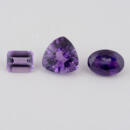
Gem in the Spotlight: Amethyst
…so keep that in mind when storing your amethyst jewelry. If you have an amethyst ring or other piece of jewelry with diamonds or other gemstones, you should be careful when cleaning it. You should use a soft brush to gently scrub the … with the clergy and was often used in the design of religious objects. It was also believed to have the power to bring about sobriety and was given to people who were struggling with addiction. Wine glasses were even carved out of …
-
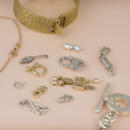
Types of Jewelry Clasps
…production of jewelry, and the demand for simpler, more affordable clasps grew. This led to the development of the spring ring clasp, which is still widely used today. The spring ring clasp features a small, spring-loaded mechanism that …. Other types of jewelry clasps that emerged in the 20th century include the lobster clasp, which features a spring-loaded mechanism that opens and closes by pressing a small lever, and the toggle clasp, which consists of a bar that …
-
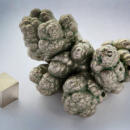
What to Do When Your Ring Irritates Your Skin
…try a new design. We do custom jewelry design , and one of our favorite projects is to take the raw materials (gold, diamonds, gemstones, etc.) from a client’s existing ring and use them to make a new and exciting creation. We can reuse the …Nothing is more frustrating than being unable to wear your engagement ring or other jewelry because it irritates your skin. Don’t worry. There are many options you have when faced with this …but their root causes and solutions are very different. Physical Irritation This can be caused by the design of the ring, a rough area that is the result of normal wear and tear, or a ring that is not sized correctly. If the ring is too …
-
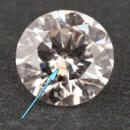
What Are Lab Grown Diamonds?
In the simplest terms, lab grown diamonds are diamonds that have been made by people instead of mined out of the earth. If it’s so simple, you might wonder …this sentence. The complexity arises from the fact that lots of different terms have been used to describe lab grown diamonds and their cousins, and not everyone uses these terms in the same way. So, let’s begin with some vocabulary. … mean man-made, copied, unreal, or even imitation. But, in this context, what do we mean when we say “synthetic diamond”? In the gemological world, synthetic is a highly technical term. When speaking technically, synthetic gems are man-made …
-

How Are Lab Grown Diamonds Made?
The dream of making a beautiful and valuable diamond from simple carbon has long captivated the imagination of scientists and visionaries alike. Just like the alchemists…, many have tried to achieve this impressive feat. We have only recently been able to produce gem quality, lab grown diamonds that are large enough to be used in jewelry. But, how is it done? Early Efforts Throughout history, many people …. Henri Moissan was one of the early pioneers in the field. In 1893, he claimed to have successfully made a diamond by heating charcoal to 3,500 degrees Celsius inside a carbon crucible. Many attempts were made to reproduce his techniques …
-
Caring for and Cleaning Your Jewelry
How to Clean Jewelry A diamond‘s spectacular beauty is due to its light show. Diamonds make light reflect, show its many colors, and dazzle. To … and lotions add a coating that stops the light show. Dust and dirt stick to the grease and oils creating a lifeless diamond. Cleaning your diamond jewelry at home is simple and rewarding. Use a soft toothbrush and mild soap then rinse … key to diamond cleaning is the underneath side or pavilion. The light needs a clean surface to bounce upward. The diamond may need to be scrubbed several times before all the build up is removed. Some don’ts of jewelry cleaning. Never use …
-
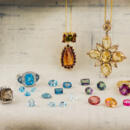
Gem in the Spotlight: Topaz
…ht. History and Lore Topaz in its pure form is naturally colorless, clear like a diamond. The famous “Braganza Diamond” was thought to be the largest diamond ever found (prior to the Cullinan Diamond) at 1,680 carats and was set in the Portu… to put coatings on lenses for glasses and cameras. It is also one of the processes that is used to create lab grown diamonds . A thin, multi-colored film is bonded on the surface of colorless topaz to create all the colors you see in Mystic…
-
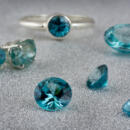
Gem in the Spotlight: Blue Zircon
… of zircon creates one of the liveliest displays found in any colored gem. In fact, before any of the manmade diamond simulates were made, the colorless version of zircon was used in jewelry to mimic diamond. Why? Natural zircon is known for…, brown, or red variety of Zircon. Jargon is the colorless, pale gray, or pale yellow variety of Zircon. Matura Diamond is another trade name for colorless Zircon. Starlite is the name for the blue gem variety of Zircon. The color of …
-
Synthetic Gems: The Whole Story
… to plastic to high tech chemical tongue twister like gadolinium gallium garnet (also called GGG) and the modern diamond simulant Moissanite, a man made silicon carbide. In gemology, any material used to look like a gem is called a simulant… clear glass, rock quartz, GGG, and Moissanite are all diamond simulants. They look like diamonds, but they are not diamonds. These simulants are easy for a well trained and equipped gemologist to detect. But if you had gem material that is …